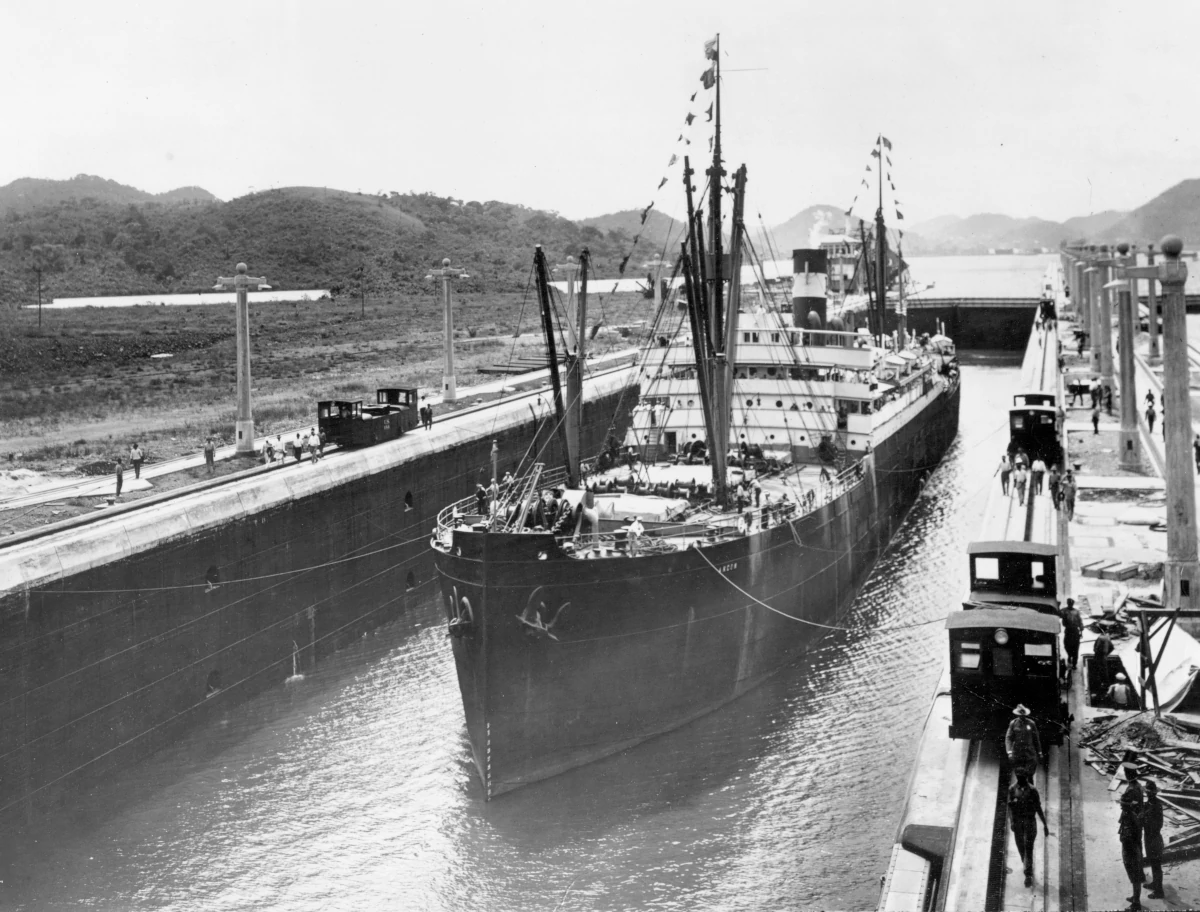
A History of the Panama Canal From Construction Days to the Present provides the highlights of Panama Canal history for the period. It encompasses the construction, operation and maintenance of the Panama Canal; it does not include political, economic, strategic, commercial or social aspects of the Canal. Hundreds of books and articles on these topics have been written and continue to be written, and interested readers are invited to consult their libraries and make use of the bibliography provided.
The Panama Canal has a length of approximately 80 kilometers between the Atlantic and Pacific oceans. Built in one of the narrowest areas of the continent, the interoceanic highway links North America with South America.
The Canal uses a system of locks – compartments with entrance and exit doors. The locks function as water lifts: they raise the ships from sea level (either Pacific or Atlantic) to the level of Gatun Lake (26 meters above sea level); thus, ships navigate through the channel of the Canal, in the Central Cordillera of Panama.
Each set of locks bears the name of the town where it was built: Gatún (on the Atlantic side), Pedro Miguel and Miraflores (on the Pacific).
The chambers – steps – of the locks are 33.53 meters wide by 304.8 meters long. The maximum dimensions for ships that wish to transit through the Canal are: 32.3 meters wide; draft – depth that reaches 12 meters of tropical fresh water; and 294.1 meters long (depending on the type of ship).
The water used to raise and lower the vessels in each set of locks is obtained from Gatun Lake by gravity: it is discharged into the locks through a main sewer system, which extends below the lock chambers from the lateral walls and the central wall.
The Culebra Cut is the narrowest part of the Canal. It extends from the northern end of the Pedro Miguel Locks to the southern end of Gatún Lake, in Gamboa. This segment, approximately 13.7 kilometers long, was excavated through rock and limestone from the Cordillera Central.
Ships from all over the world transit through the Panama Canal daily. Between 13,000 and 14,000 ships use the Canal each year. In fact, we proudly serve more than 180 maritime routes, connecting 1,920 ports across 170 countries.
With the work of approximately 9 thousand workers, the Canal operates 24 hours a day, 365 days a year, offering transit service to ships from all nations without any discrimination.
Our live cameras will allow you to observe the operation of the Canal in real time.
The Panama Canal Authority (ACP) is an autonomous legal person of Public Law created by Title XIV of the Political Constitution of the Republic of Panama, and which is exclusively responsible for the administration, operation, conservation, maintenance and modernization of the Canal of Panama, as well as its related and complementary activities, in accordance with the constitutional and legal norms in force, in order for it to function in a safe, continuous, efficient and profitable manner.
The Organic Law of the ACP, of June 11, 1997 establishes the norms for its organization and operation. Due to its importance and nature, the ACP enjoys financial autonomy, its own assets and the right to administer it.
The regime contained in Title XIV may only be developed by laws that establish general rules. And the Board of Directors has among its constitutional powers the exclusive approval of the regulations that develop the general rules, on the contracting, purchasing and all matters necessary for the better operation, maintenance, conservation and modernization of the Canal.
The ACP is directed by an Administrator and a Deputy Administrator, under the supervision of a Board of Directors made up of 11 members. The Administrator is the highest-ranking executive officer, legal representative of the entity and responsible for its administration and for the execution of the policies and decisions of the Board of Directors. The appointment of the Administrator is for a period of seven years, after which he may be re-elected for an additional period.
The 11 members of the Board of Directors are appointed as follows:
The appointment of the first Board of Directors was made for staggered periods to guarantee its independence from the governments of the day. The Panama Canal constitutes an inalienable patrimony of the Panamanian nation, therefore it cannot be sold, assigned, or mortgaged, or, in any other way, encumbered or disposed of. The legal regime that was established for the Panama Canal Authority has the fundamental objective of preserving the conditions that make the Canal a company at the peaceful and uninterrupted service of the maritime community, international trade and Panama.
The Republic of Panama made various efforts to ensure the imperceptible transfer of the Canal. The first step was taken in 1994 when Panama modified its National Constitution to include a title on the Panama Canal. The second occurred on May 14, 1997, when the Legislative Assembly approved the organic law of the Panama Canal Authority, which served as the basis for the final regulations governing the daily activities and operations of the waterway.
Both the Constitutional Title and the Organic Law establish that the Canal must be an efficient, profitable company and a pillar of the human and socioeconomic development of the country.